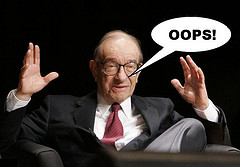 The term money supply is one of those phrases that, when uttered at a dinner party, is likely to trigger mass narcolepsy. Not been sleeping well lately and want to try an alternative to counting sheep? Imagine Alan Greenspan whispering the words “money supply” into your ear over and over. You’ll be asleep soon, friend. Well, either that or on a dead screaming run from the bedroom to the nearest phone to alert police about the presence of an intruder. Former Fed Chairman or not, he’s got no business breaking into your house like that.
The term money supply is one of those phrases that, when uttered at a dinner party, is likely to trigger mass narcolepsy. Not been sleeping well lately and want to try an alternative to counting sheep? Imagine Alan Greenspan whispering the words “money supply” into your ear over and over. You’ll be asleep soon, friend. Well, either that or on a dead screaming run from the bedroom to the nearest phone to alert police about the presence of an intruder. Former Fed Chairman or not, he’s got no business breaking into your house like that.
But back to money supply.
The concept itself is quite simple. The United States money supply is comprised of all the currency and coins issued by the Federal Reserve System and the US Treasury, plus some kinds of checking and savings deposits held by the public at commercial banks, thrifts and credit unions. It’s not terribly complicated but more so than it used to be, since the definition of money supply has changed so much over the years. Originally, physical commodities, usually gold and silver, were the sum total of a nation’s money supply. Then along came paper money and checkable deposits which were convertible into commodity, most commonly gold. That practice came to a screeching halt on August 15, 1971, when President Richard Nixon discontinued the practice of keeping gold in reserve in the amount of the currency and coinage presently in circulation. That’s why the powers that be in the Fed and Treasury Department can fire up the currency printing presses to their heart’s content, constrained by neither legalities or common sense.
But why does anyone even care about money supply in the first place, other than as the answer to an esoteric question? The reality is that money supply has a very real effect on economic activity in the United States. Increasing or decreasing the money supply is a common tactic undertaken by the Federal Reserve. For example, lowering interest rates is believed to spur investments by putting more money in the hands of the public, who suddenly feel wealthier and start spending more freely. Increased demand for products leads to businesses ordering more raw materials and an accompanying rise in production.
The most important determinant of money supply is the Federal Reserve, who controls supply through banking reserve deposits but that’s another topic for another day. Too much at once has been proven to cause brain implosion. You need rest. Where is Alan Greenspan when you need him?
The American Monetary Association Team
Flickr / Mike Licht, NotionsCapital.com

